Beatrix of the Netherlands
Beatrix[1] (Beatrix Wilhelmina Armgard, Dutch pronunciation: [ˈbeːjaːtrɪks ˌʋɪlɦɛlˈminaː ˈʔɑrmɡɑrt] (![]()
| Beatrix | |||||
|---|---|---|---|---|---|
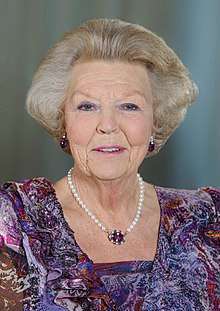 | |||||
| Queen of the Netherlands | |||||
| Reign | 30 April 1980 – 30 April 2013 | ||||
| Inauguration | 30 April 1980 | ||||
| Predecessor | Juliana | ||||
| Successor | Willem-Alexander | ||||
| Prime Ministers | |||||
| Born | 31 January 1938 Soestdijk Palace, Baarn, Netherlands | ||||
| Spouse | Claus von Amsberg
( m. 1966; died 2002) | ||||
| Issue Detail |
| ||||
| |||||
| House | |||||
| Father | Prince Bernhard of Lippe-Biesterfeld | ||||
| Mother | Queen Juliana of the Netherlands | ||||
| Religion | Protestantism | ||||
| Signature | |||||
 |
|
|
Extended royal family HRH Princess Irene
HRH Princess Margriet *
|
| * Member of the Dutch royal house |
Beatrix is the eldest daughter of Queen Juliana and her husband, Prince Bernhard of Lippe-Biesterfeld. Upon her mother's accession in 1948, she became heir presumptive. Beatrix attended a public primary school in Canada during World War II, and then finished her primary and secondary education in the Netherlands in the post-war period. In 1961, she received her law degree from Leiden University. In 1966, Beatrix married Claus von Amsberg, a German diplomat, with whom she had three children. When her mother abdicated on 30 April 1980, Beatrix succeeded her as queen.
Beatrix's reign saw the country's Caribbean possessions reshaped with Aruba's secession and becoming its own constituent country within the kingdom in 1986. This was followed by the dissolution of the Netherlands Antilles in 2010, which created the new special municipalities of Bonaire, Sint Eustatius, and Saba, and the two new constituent countries of Curaçao and Sint Maarten.
On Koninginnedag (Queen's Day), 30 April 2013, Beatrix abdicated in favour of her eldest son, Willem-Alexander.[2] At the time of her abdication at age 75, Beatrix was the oldest reigning monarch in the country's history.[3]
Early life
Beatrix Wilhelmina Armgard was born on 31 January 1938 at the Soestdijk Palace in Baarn, Netherlands, as the first child of Princess Juliana and Prince Bernhard of Lippe-Biesterfeld.[4] Beatrix was baptized on 12 May 1938 in the Great Church in The Hague.[5] Her five godparents were King Leopold III of Belgium; Princess Alice, Countess of Athlone; Elisabeth, Princess of Erbach-Schönberg; Duke Adolf Friedrich of Mecklenburg; and Countess Allene de Kotzebue.[6] Beatrix's middle names are the first names of her maternal grandmother, the then reigning Queen Wilhelmina, and her paternal grandmother, Princess Armgard of Sierstorpff-Cramm.
When Beatrix was one year old, in 1939, her younger sister Princess Irene was born.[4]
.jpg)
World War II broke out in the Netherlands on 10 May 1940 (Westfeldzug). On 13 May, the Dutch Royal Family evacuated to London, United Kingdom. One month later, Beatrix went to Ottawa, Ontario, Canada, with her mother Juliana and her sister Irene, while her father Bernhard and maternal grandmother Queen Wilhelmina remained in London.[4] The family lived at the Stornoway residence (now the residence of the Leader of the Opposition in the Parliament of Canada).[7] With bodyguards and ladies in waiting, the family summered at Bigwin Inn on Lake of Bays, Ontario where four private stone cottages of the resort served as their retreat. While on Bigwin Island, the constitution of the Netherlands was stored in the safe of Bigwin Inn's Rotunda building. Princess Juliana and her family were remembered for their "down to earth" friendliness, general gratefulness and great reverence for their homeland and people, to whom they paid homage by refraining from all luxuries offered to guests at the resort that was once billed as the largest and most luxurious summer resort in Canada. In order to provide them with a greater sense of security, culinary chefs and staff catered to personal orders at meal time. Upon their departure, the hotel musicians of the Bigwin Inn Orchestra assembled dockside; and at every public performance afterward through to the end of World War II, the Wilhelmus was played. In the years following the shuttering and neglect of the island resort, the "Juliana" cottages were well maintained and preserved in an informal tribute to Princess Juliana and her family. In thanks for the protection of her and her daughters, Princess Juliana established the custom of the delivery to the Canadian government every spring of tulips, which are the centrepiece of the Canadian Tulip Festival.
The second sister of Beatrix, Princess Margriet, was born in Ottawa in 1943.[4] During their exile in Canada, Beatrix attended nursery and[8] Rockcliffe Park Public School, a primary school where she was known as "Trixie Orange".[9][10]
On 5 May 1945, the German troops in the Netherlands surrendered. The family returned to the Netherlands on 2 August 1945. Beatrix went to the progressive primary school De Werkplaats in Bilthoven. Her third sister Princess Christina was born in 1947.[4] On 6 September 1948, her mother succeeded her grandmother Wilhelmina as Queen of the Netherlands, and Beatrix became the heir presumptive to the Dutch throne at the age of ten.
Education
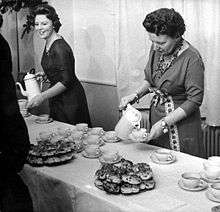
In April 1950, Princess Beatrix entered the Incrementum, a part of Baarnsch Lyceum, where, in 1956, she passed her school graduation examinations in the subjects of arts and classics.[11]
In 1954, Beatrix served as bridesmaid at the wedding of Baroness van Randwijck and Mr T Boey.[12]
On 31 January 1956 Beatrix celebrated her 18th birthday. From that date, under the Constitution of the Netherlands, she was entitled to assume the Royal Prerogative. At that time, her mother installed her in the Council of State.[13]
The same year her studies at Leiden University began. In her first years at the university, she studied sociology, jurisprudence, economics, parliamentary history and constitutional law.[11] In the course of her studies she also attended lectures on the cultures of Suriname and the Netherlands Antilles, the Charter for the Kingdom of the Netherlands, international affairs, international law, history and European law
The princess also visited various European and international organisations in Geneva, Strasbourg, Paris, and Brussels. She was also an active member of the VVSL (Female Union for Students in Leiden), now called L.S.V. Minerva, after merging with the Leidsch Studenten Corps (which before then was male-only). In the summer of 1959, she passed her preliminary examination in law, and she obtained her law degree in July 1961.[11]
Political involvement
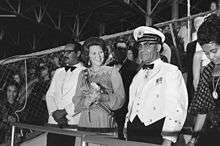
Her appearance on the political scene was almost immediately marked by controversy. In 1965, Beatrix became engaged to the German aristocrat Claus von Amsberg, a diplomat working for the German Foreign Office. There was a massive protest on their wedding day in Amsterdam on 10 March 1966. Prince Claus had served in the Hitler Youth and the Wehrmacht and was therefore associated by some of the Dutch population with German Nazism. Protests included such memorable slogans as "Claus 'raus!" (Claus out!) and "Mijn fiets terug" ("Return my bicycle" – a reference to occupying German soldiers confiscating Dutch bicycles during WWII). A group of Provos threw a smoke bomb at the Golden Coach, resulting in a violent street battle with the police. But as time went on, Prince Claus became one of the most popular members of the Dutch monarchy, and his death in 2002 was widely mourned.
On 25 November 1975, Beatrix and Prince Claus attended the independence ceremony of Suriname, held in the new nation's capital, Paramaribo, representing her mother the Queen.
There was an even more violent riot on 30 April 1980, during Beatrix's investiture (sovereigns of the Netherlands are not crowned as such). Some people, including socialist squatters, used the occasion to protest against poor housing conditions in the Netherlands and against the monarchy in general, using the slogan "Geen woning; geen Kroning" (No home, no coronation). There were violent clashes with the police and security forces. This event is reflected in contemporary Dutch literature in the books of A.F.Th. van der Heijden.
As monarch, Beatrix had weekly meetings with the prime minister. She signed all new Acts of Parliament and royal decrees, and until a constitutional change late in her reign, appointed the informateur, an official who is responsible for chairing coalition talks in the formation of new governments. At the state opening of parliament each September, she delivered the Speech from the Throne, in which the government announces its plans for the coming parliamentary year. As queen, she was president of the Council of State. Her role was largely ceremonial and as a focus of national unity; she did not make legislative or executive decisions.
Beatrix is a member of the Bilderberg Group.[14]
Marriage and children

On 28 June 1965, the engagement of Princess Beatrix to the German diplomat Claus von Amsberg was announced. Claus and Beatrix had met at the wedding-eve party of Princess Tatjana of Sayn-Wittgenstein-Berleburg and Moritz, Landgrave of Hesse, in summer 1964. Following the consent of Parliament to the marriage, Claus von Amsberg became a Dutch citizen, and upon his marriage became Prince Claus of the Netherlands, Jonkheer van Amsberg.
Beatrix married Claus von Amsberg on 10 March 1966 in civil and religious ceremonies.[15] The bride wore a traditional gown with train in duchesse silk satin, designed by Caroline Bergé-Farwick of Maison Linette, in Den Bosch, and the Württemberg Ornate Pearl Tiara. The senior bridesmaids were the bride’s youngest sister, Princess Christina of the Netherlands; Princess Christina of Sweden, Lady Elizabeth Anson, Joanna Roëll, Eugénie Loudon and the bridegroom’s sister, Christina von Amsberg. The junior bridesmaids were Daphne Stewart-Clark and Carolijn Alting von Geusau, with page boys Joachim Jencquel and Markus von Oeynhausen-Sierstorpff.[16]
The royal couple travelled to the ceremony together in the gold state carriage.[17] The civil ceremony was conducted by the Mayor of Amsterdam, Gijsbert van Hall, at Amsterdam City Hall. The marriage blessing took place in the Westerkerk, conducted by the Rev. Hendrik Jan Kater, with a sermon by the Rev. Johannes Hendrik Sillevis Smitt.[18]
The royal couple had three sons:
- King Willem-Alexander (born 1967)
- Prince Johan Friso, known as "Friso" (1968–2013)[19]
- Prince Constantijn (born 1969).
They lived at Drakensteyn Castle in Lage Vuursche with their children until Beatrix ascended the throne. In 1981, they moved into Huis ten Bosch Palace in The Hague.
Reign
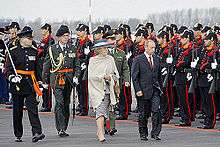
On 30 April 1980, Beatrix became the monarch when her mother abdicated. She was sworn-in and inaugurated as monarch during a joint session of the two chambers of the States General at a ceremony held in the Nieuwe Kerk in Amsterdam later that day.
Beatrix's constitutional duties included those typically accorded to a head of state; this includes having to sign every piece of legislation before it becomes law, formally appointing various officials, receiving and accrediting ambassadors, and awarding honours and medals, among others. Outside of these constitutional duties, her other informal roles included being the highest representative of the kingdom internationally and to be a unifying figure locally.
Beatrix was rarely quoted directly in the press during her reign since the government information service (Rijksvoorlichtingsdienst) made it a condition of interviews that she may not be quoted. This policy was introduced shortly after her inauguration, reportedly to protect her from political complications that may arise from "off-the-cuff" remarks. It did not apply to her son Prince Willem-Alexander.
Throughout much of her reign Beatrix had a considerable role in the cabinet formation process; notably she appointed the informateur, the person who leads the negotiations that ultimately lead to the formation of a government. However, this was changed in 2012, and now the largest party in the States General appoints a "scout" who then appoints an informateur.
On 1 January 1986, Aruba seceded from the Netherlands Antilles and became a separate constituent country in the Dutch Kingdom.
On 6 October 2002, the Queen's husband, Prince Claus, died after a long illness. A year and a half later her mother died after long suffering from senile dementia, while her father succumbed to cancer in December 2004.
On 8 February 2005, Beatrix received a rare honorary doctorate from Leiden University, an honour the Queen does not usually accept. In her acceptance speech she reflected on the monarchy and her own 25 years as Queen.[20] The speech was broadcast live.[21]
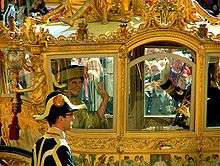
On 29 and 30 April 2005, she celebrated the 25th anniversary of her reign. She was interviewed on Dutch television, was offered a concert on Dam Square in Amsterdam, and a celebration took place in The Hague, the country's seat of government.
On 31 May 2006 the 6th Polish Air Assault Brigade would receive the Militaire Willemsorde der 4e klasse in The Hague. Beatrix was to tie the prestigious medal to the standard of the incumbents of the 1st Independent Polish Parachute Brigade.[22]
On 10 October 2010, the Netherlands Antilles were formally dissolved. The new municipalities of Bonaire, Sint Eustatius, and Saba and the new constituent countries of Curaçao and Sint Maarten were established in its place. The dissolution ceremony in the Netherlands Antilles' capital, Willemstad, was attended by the then-Prince and Princess of Orange, Willem-Alexander and his wife Máxima, representing the Queen.
Kissed by a bystander
During 1988 Queen's Day, Queen Beatrix was kissed by a bystander, later identified as Maarten Rijkers, when she walked through the crowd of people at a flea market in the Jordaan. When Beatrix walked alongside Rijkers he said "Give me a kiss, girl", after which he gave her a hug and two kisses.[23] It received wide media attention and appeared to be an historical moment.[24][25] An image of this scene was large at the front page of De Telegraaf. It is later seen as an historical moment of the Netherland. Even 25 years later in 2013, NRC Handelsblad wrote an article about it and the impact of it.[24]
The reaction of the Queen was by people seen as very positive and was a boost for her reputation. Some have said the situation might have been staged.[24][25]
Attack on the royal family
On 30 April 2009, the Queen and other members of the royal family were targeted in a car attack by a man named Karst Tates. Tates crashed his car into a parade in Apeldoorn, narrowly missing a bus carrying the Queen. Five people were killed instantly and two victims and the assailant Tates died later. Other victims of the crash were critically hurt. One week after the attack, another victim succumbed to the injuries he had sustained. The royal party were unharmed, but the Queen and members of her family saw the crash at close range. Within hours, Beatrix made a rare televised address to express her shock and condolences. The man reportedly told police he was deliberately targeting the royal family.[26]
Abdication
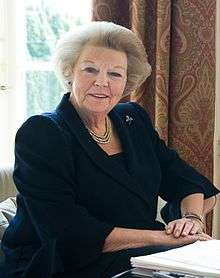
In a broadcast on national media on 28 January 2013, Beatrix announced her intention to abdicate on 30 April (Queen's Day), when she would have been on the throne for exactly 33 years. Beatrix stated that it was time to "place the responsibility for the country in the hands of a new generation."[27] Her heir apparent was her eldest son, Prince Willem-Alexander.[28] She was the third successive Dutch monarch to abdicate, following her grandmother and her mother.[28] The broadcast was followed by a statement from Prime Minister Mark Rutte who paid tribute to Beatrix, saying "Since her investiture in 1980, she has applied herself heart and soul to Dutch society."[27]
The official programme for the abdication and inauguration took place on 30 April 2013. Beatrix signed the instrument of abdication in the Vroedschapkamer (also known as Mozeszaal)[29] in the Royal Palace, Amsterdam at 10:07 a.m. local time. With the completion of her signature, she was no longer monarch. The inauguration of Willem-Alexander as king took place that afternoon in the Nieuwe Kerk in Amsterdam.[30]
Personal wealth

In 2009, Forbes estimated her wealth at US$300 million.[31]
Post-abdication
Princess Beatrix continues to undertake some royal duties and is patron of many organisations. She now lives in the small moated Drakensteyn Castle near the village of Lage Vuursche.[32]
Cultural impact
Beatrix has given her name to a number of facilities in the Netherlands and beyond. These include:
- Streekziekenhuis Koningin Beatrix, regional hospital in Beatrixpark, Winterswijk.[33]
- Queen Beatrix International Airport in Aruba.
- Reina Beatrix School in Aruba.[34]
- Queen Beatrix Hospital Medical Center, Sint Eustatius.[35]
- Queen Beatrix Chair in Dutch Studies at UC Berkeley[36]
- Queen Beatrix Nursing Home, Albion Park Rail, NSW, Australia.[37]
A few parks in the country also bear her name:
- Beatrixpark in the Oud-Zuid neighbourhood in Amsterdam.
- Beatrixpark in Almere.
- Beatrixpark in 's-Hertogenbosch.
- Beatrixpark in Utrecht.
- Beatrixpark in Schiedam.
It has been speculated that Beatrix is De Onbekende Beeldhouwer (Unknown Sculptor), whose work has been appearing in Amsterdam since 1983. There has been no confirmation of this.[38]
Titles, styles, honours and arms

- 31 January 1938 – 30 April 1980: Her Royal Highness Princess Beatrix of the Netherlands, Princess of Orange-Nassau, Princess of Lippe-Biesterfeld[39]
- 30 April 1980 – 30 April 2013: Her Majesty The Queen of the Netherlands, Princess of Orange-Nassau, Princess of Lippe-Biesterfeld[39]
- 30 April 2013 – present: Her Royal Highness Princess Beatrix of the Netherlands, Princess of Orange-Nassau, Princess of Lippe-Biesterfeld[39]
Princess Beatrix has held titles throughout her life, as a granddaughter or daughter of a monarch, and eventually as the Sovereign. Beatrix's official title was Her Majesty the Queen of the Netherlands, Princess of Orange-Nassau, etc., etc., etc.[39] The triple etc. refers to the monarch's many dormant titles. She signed official documents with only "Beatrix". In common parlance she was referred to as The Queen (de koningin or de vorstin) or Her Majesty (Hare Majesteit). But when in conversation with the queen the practice was to initially address her as "Your Majesty" or in Dutch as "Uwe Majesteit"[40] and thereafter as "Mevrouw" (ma'am).[41]
Beatrix has received honours and awards from countries around the world, both during her life as a princess and as a monarch. In her capacity as the Sovereign she was Grand Master of the Military Order of William (Militaire Willemsorde) and the other Dutch orders of merit. She is a Stranger Lady of the Most Noble Order of the Garter and the 1,187th Dame of the Order of the Golden Fleece in Spain, and she has received numerous other medals and decorations.
From birth till her inauguration as queen she had the following name and titles, to which she reverted after her abdication: Her Royal Highness Princess Beatrix of the Netherlands, Princess of Orange-Nassau, Princess of Lippe-Biesterfeld.[42]
Arms
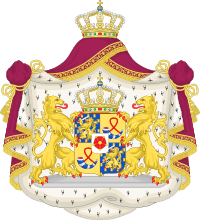 |
Azure, billetty Or a lion with a coronet Or armed and langued Gules holding in his dexter paw a sword Argent hilted Or and in the sinister paw seven arrows Argent pointed and bound together Or. |
Issue
| Name | Birth | Death | Marriage | ||
|---|---|---|---|---|---|
| Date | Spouse | Issue | |||
| Willem-Alexander of the Netherlands | 27 April 1967 | 2 February 2002 (wedding) |
Máxima Zorreguieta Cerruti | ||
| Prince Friso of Orange-Nassau | 25 September 1968 | 12 August 2013 | 24 April 2004 | Mabel Wisse Smit |
|
| Prince Constantijn of the Netherlands | 11 October 1969 | 19 May 2001 | Laurentien Brinkhorst |
| |
Ancestry
| Ancestors of Beatrix of the Netherlands |
|---|
Prime Ministers during her reign
| Polity | Prime Minister | Start year | End year |
|---|---|---|---|
| Aruba | Henny Eman | 1986 | 1989[43] |
| Nelson O. Oduber | 1989 | 1994 | |
| Henny Eman | 1994 | 2001 | |
| Nelson O. Oduber | 2001 | 2009 | |
| Mike Eman | 2009 | 2013 | |
| Netherlands | Dries van Agt | 1977 | 1982 |
| Ruud Lubbers | 1982 | 1994 | |
| Wim Kok | 1994 | 2002 | |
| Jan Peter Balkenende | 2002 | 2010 | |
| Mark Rutte | 2010 | 2013 | |
| Netherlands Antilles | Dominico Martina | 1979 | 1984 |
| Maria Liberia Peters | 1984 | 1986 | |
| Dominico Martina | 1986 | 1988 | |
| Maria Liberia Peters | 1988 | 1993 | |
| Susanne Camelia-Römer | 1993 | ||
| Alejandro Felippe Paula | |||
| Miguel Arcangel Pourier | 1994 | 1998 | |
| Susanne Camelia-Römer | 1998 | 1999 | |
| Miguel Arcangel Pourier | 1999 | 2002 | |
| Etienne Ys | 2002 | 2003 | |
| Ben Komproe | 2003 | ||
| Mirna Louisa-Godett | 2003 | 2004 | |
| Etienne Ys | 2004 | 2006 | |
| Emily de Jongh-Elhage | 2006 | 2010 | |
| Curaçao | Gerrit Schotte | 2010 | 2012 |
| Stanley Betrian | 2012 | 2012 | |
| Daniel Hodge | 2012 | 2013 | |
| Sint Maarten | Sarah Wescot-Williams | 2010 | 2013 |
References
- Members of the Royal House: Princess Beatrix of the Netherlands - official website of the Royal house of the Netherlands
- de Jong, Perro (30 April 2013). "The Netherlands' love and respect for Beatrix". BBC. Retrieved 5 June 2015.
- Myrtille van Bommel, "Beatrix oldest Dutch reigning monarch Archived 3 November 2013 at the Wayback Machine", Radio Netherlands Worldwide, 2011. Retrieved on 2012-05-15.
- Youth Archived 5 May 2009 at the Wayback Machine. The Dutch Royal House. Retrieved on 2008-07-11.
- (in Dutch) Geschiedenis Archived 4 October 2015 at the Wayback Machine, Grote Kerk Den Haag. Retrieved on 2012-05-15.
- De vijf peetouders van prinses Beatrix. The Memory of the Netherlands. Retrieved on 2008-07-11.
- "CBC News". Cbc.ca. 18 January 2008. Retrieved 5 March 2010.
- Education Archived 5 May 2009 at the Wayback Machine. The Dutch Royal House. Retrieved on 2008-07-11.
- Davison, Janet. "Abdicating Dutch queen was a wartime Ottawa schoolgirl". CBC.ca. Canadian Broadcasting Corporation. Retrieved 29 April 2013.
- "National Capital Commission". Canadascapital.gc.ca. Archived from the original on 13 October 2009. Retrieved 2010-03-05.
- "Het Koninklijk Huis". Koninklijkhuis.nl. Archived from the original on 25 February 2010. Retrieved 5 March 2010.
- "Princess Beatrix Bridesmaid At Wedding". British Pathe.
- "e CV Reine Beatrix". www.coe.int. Retrieved 20 January 2017.
- "Bilderberg Meeting of 1997 Assembles". PR Newswire. 13 June 1997. Archived from the original on 30 April 2011.
- "Video: Wedding of Princess Beatrix and Claus von Amsberg". YouTube.
- "Royal wedding Beatrix and Claus".
- "Wedding of Princess Beatrix and Claus von Amsberg". Amsterdam Palace. Archived from the original on 17 April 2016.
- "Queen Beatrix: marriage and family". Dutch Royal House. Archived from the original on 26 June 2012.
- Prins Friso overleden (nl) Telegraaf.nl
- Archived 5 April 2005 at the Wayback Machine
- The complete broadcast
- "Chapter 8. The process of Polish rehabilitation in 2006". Polish forces in the West. Archived from the original on 5 January 2019. Retrieved 10 January 2016.
- Communicatie, FIZZ Marketing &. "Ons Amsterdam | 130 jaar koninklijk feest in de hoofdstad". onsamsterdam.nl.
- "Special Beatrix". Issuu.
- "Markante momenten Beatrix". nos.nl.
- NO. "Koninklijke familie was doelwit (Royal family was the target) (Dutch)". Archived from the original on 3 May 2009. Retrieved 1 May 2009.
- "Dutch Queen to abdicate in April for son". Al Jazeera. 28 January 2013. Retrieved 28 January 2013.
- "Queen Beatrix of the Netherlands to abdicate for son". BBC. 28 January 2013. Retrieved 28 January 2013.
- "Time and place of abdication and investiture, 28 January 2013". Royal Dutch House.
- "In Pictures: The World's Richest Royals". www.forbes.com. Forbes.com. 30 August 2007. Retrieved 5 March 2010.
- (Dutch) Verhuizing Prinses Beatrix, Koninklijk Huis. Retrieved 24 July 2013.
- services, HPU internet. "Home | SKB Winterswijk". www.skbwinterswijk.nl. Retrieved 18 November 2019.
- "List of Schools - VisitAruba.com". www.visitaruba.com. Retrieved 18 November 2019.
- University of Sint Eustatius School of Medicine "Archived copy". Archived from the original on 28 December 2011. Retrieved 28 March 2016.CS1 maint: archived copy as title (link)
- Archived 19 July 2012 at the Wayback Machine
- "Queen Beatrix Nursing Home | Zadro Constructions". www.zadro.com.au. Retrieved 18 November 2019.
- Depictions, text in Dutch Retrieved 23 June 2017.
- H.M. (koningin Beatrix) Beatrix Wilhelmina Armgard Archived 16 June 2012 at the Wayback Machine (Parlement.nl)
- "The Dutch Royal House; FAQ; "How should I address members of the Royal House?"". Archived from the original on 10 June 2007. Retrieved 29 June 2008.
- Van den Bor, Conny (29 April 2010). "Queen Beatrix – still impeccable after 30 years". Radio Netherlands Worldwide. Archived from the original on 11 November 2013. Retrieved 28 January 2013.
- "Prins van Oranje wordt Koning Willem-Alexander" (in Dutch). Website of the Royal House. 28 January 2013. Retrieved 28 January 2013.
- Aruba received status aparte in 1986.
External links
| Wikimedia Commons has media related to Beatrix of the Netherlands. |
- Her Royal Highness Princess Beatrix: Official website
- Newspaper clippings about Beatrix of the Netherlands in the 20th Century Press Archives of the ZBW
Beatrix of the Netherlands Born: 31 January 1938 | ||
| Regnal titles | ||
|---|---|---|
| Preceded by Juliana |
Queen of the Netherlands 1980–2013 |
Succeeded by Willem-Alexander |
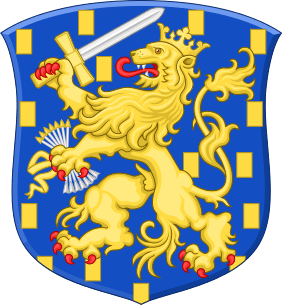
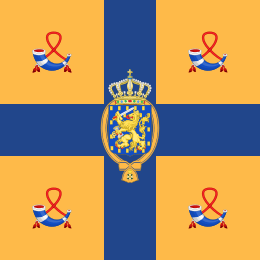
.svg.png)
